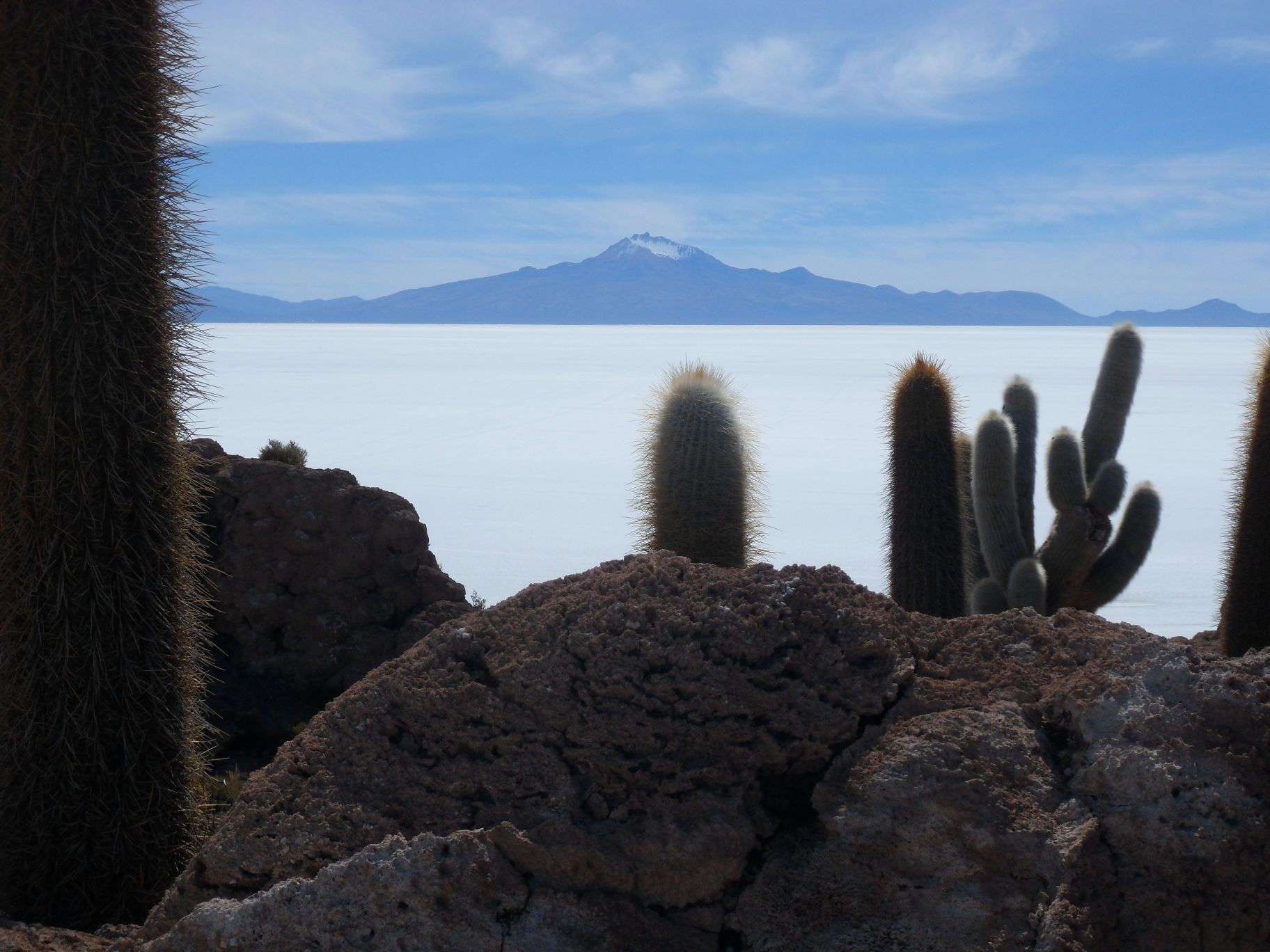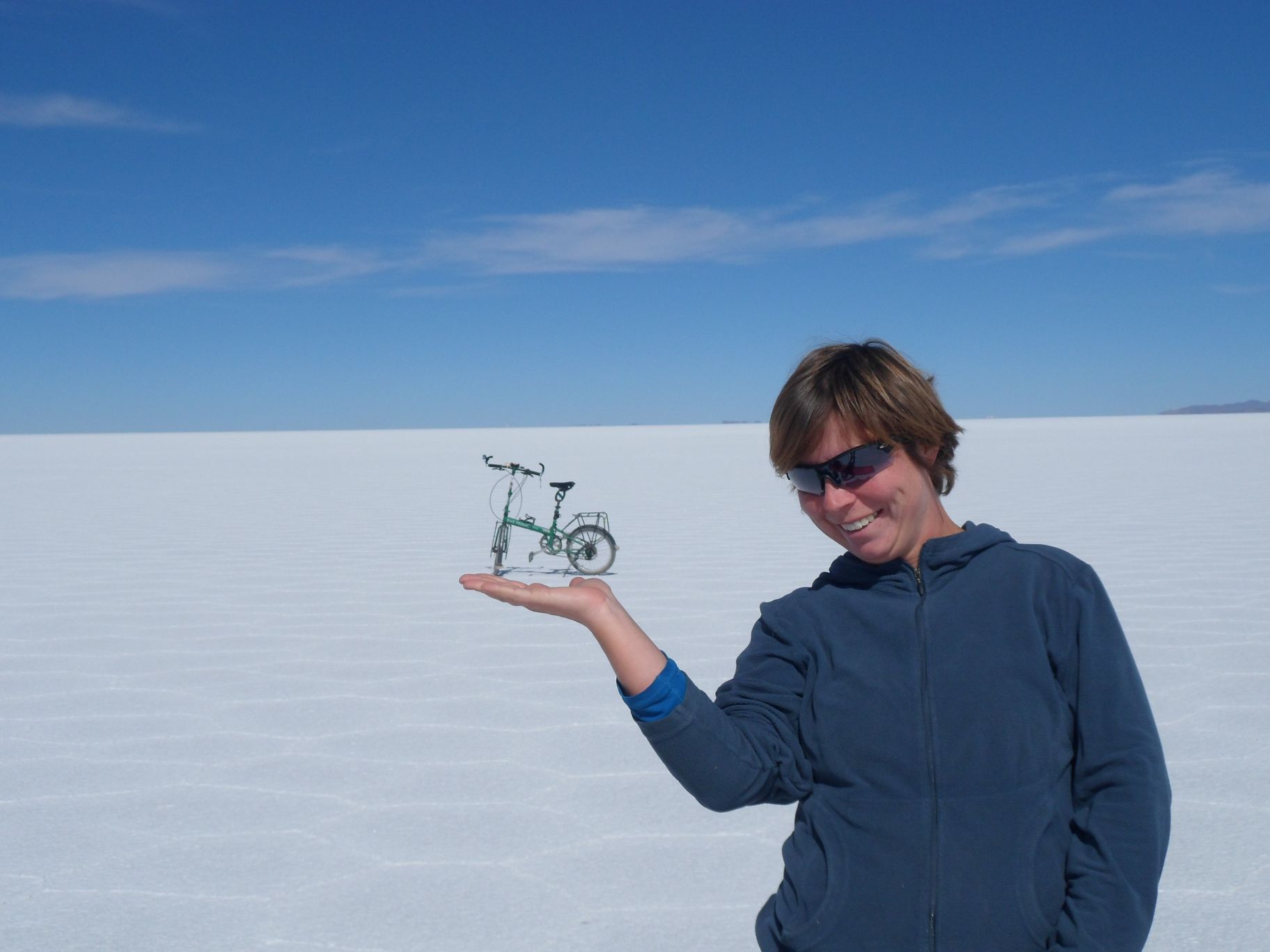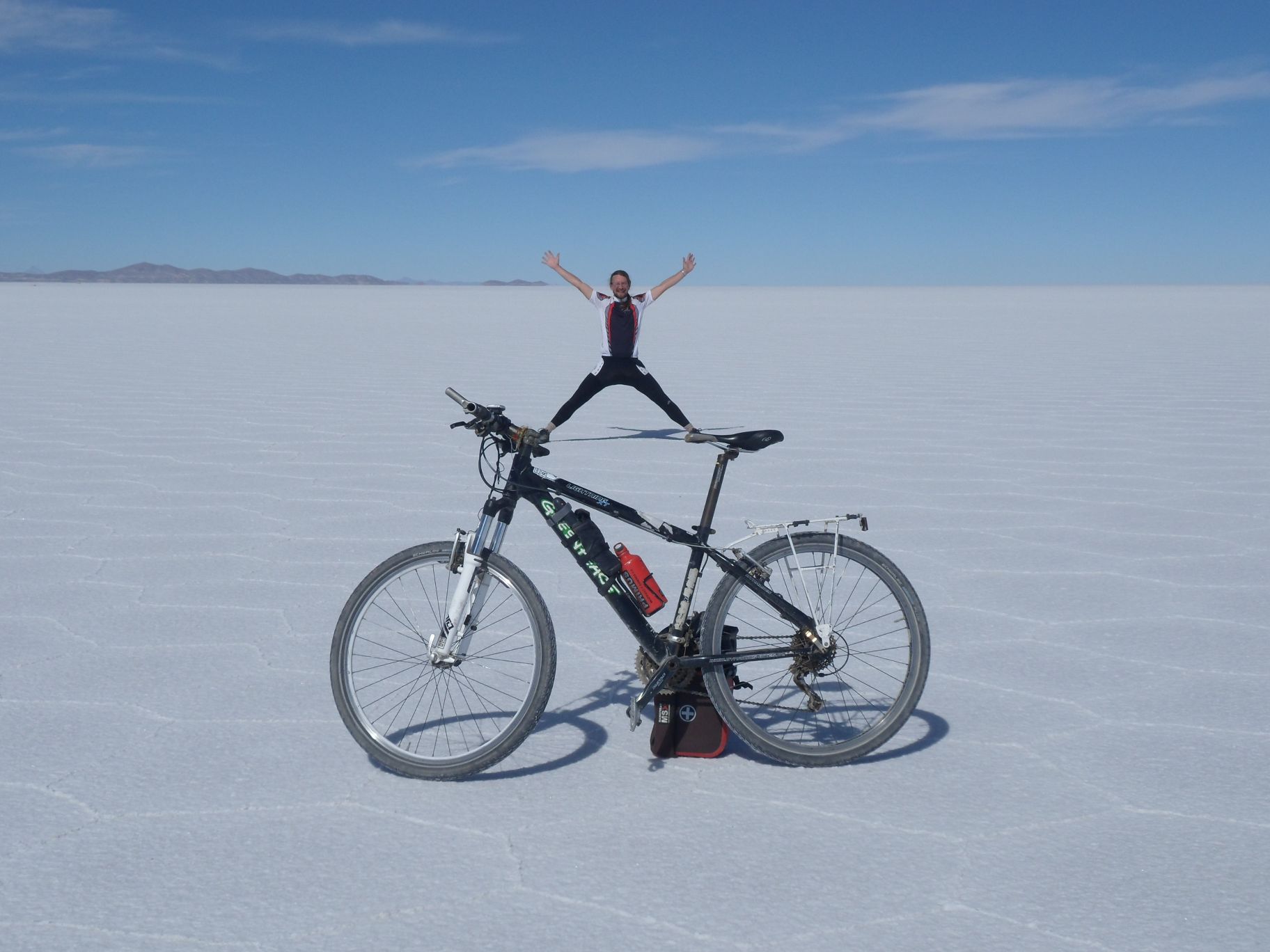 Uyuni is an interesting town. It is the major settlement on the worlds largest salt lake as well as the major departure point for the Jeep tours to the lagoons in the vast Southwest of Bolivia. Some old loco and a metal sculpture in front of the train station, and wide streets barely occupied with traffic give the town a bit of a Western movie feeling, except for the dozens of Landcruisers. There is a touristy pedestrian area with restaurants and souvenir shops as sort of city center, and a number of freshly painted colonial looking buildings including the church. Just a few hundred meters away the wide streets turn into wide bumpy dirt roads, with smaller unplastered red brick houses at its sides. A cold sun during the day barely warms, the usual west wind in the afternoon chills and at nightfall its getting really cold.
Uyuni is an interesting town. It is the major settlement on the worlds largest salt lake as well as the major departure point for the Jeep tours to the lagoons in the vast Southwest of Bolivia. Some old loco and a metal sculpture in front of the train station, and wide streets barely occupied with traffic give the town a bit of a Western movie feeling, except for the dozens of Landcruisers. There is a touristy pedestrian area with restaurants and souvenir shops as sort of city center, and a number of freshly painted colonial looking buildings including the church. Just a few hundred meters away the wide streets turn into wide bumpy dirt roads, with smaller unplastered red brick houses at its sides. A cold sun during the day barely warms, the usual west wind in the afternoon chills and at nightfall its getting really cold.
We do what most tourists do in Uyuni – we go on a three day jeep tour through some colorful lagoons and the Salar de Uyuni, the worlds biggest salt lake. We are a group of seven, Domingo the driver, a German couple and two young Swiss backpackers. 900 kilometers between 4000 and 5000 meters above sea level on sandy rough gravel with a handful villages – part of our cyclist minds already suffer from viewing the endless lonesome tracks we know that other bicycle travelers have done - with luggage and heaps of food and water.
But for the time being we enjoy the comfort of the warm jeep, the company and the contrast of the soft ascending reddish hills and some snow-capped mountains in the distance. Llama and Vicuna flocks dwell on the sparse dry grass. Ilian, the Swiss suggested to do the tour counterclockwise to avoid the crowds of other jeep tourists. Some 40 jeeps are on these tracks every day. That plan works out perfectly, and we have most of the sights for ourselves. Domingo, our driver would show us points of interest, explain that the locals here live from the Llamas and from growing Quinoa, a grain that only grows up here in the Altiplano. Apparently, some vegetables like potatoes and onions do grow as well here in the dry cold climate. Nowadays, mining companies are big employers here. Even a train line runs to Chile only for the valuable minerals like copper, silver and gold. Domingo would stop at small guest houses for lunch and diner, and cook simple and good meals himself with the food he carries on the jeep.
 |
 |
We reach the Laguna Colorada, one of the highlights of the tour by sunset of the first day. The water shimmers in perfect red and white and yellow in front of some mighty snow-capped peaks. White and purple flamingos wade the shallow ice cold water in the icy breeze. Not much grows here, except for a few dry grass tufts, and some water plants these graceful creatures live. Walking down to the shore to put my hand into the waters I'm really surprised, having found a hot spring spot by chance. Just as a perfect ending of the first day, the few clouds in the sky turn purple a after sunset.
 The night we'd spend in a nearby set of long stone houses that serve the jeep tourists as hospedajes. There is no heating here, just a bit of solar powered light, so we wear all our clothes at diner. In the end, Domingo serves us hot spicy wine and provides each of us a hot-water bottle for the night. Once again I'm more than happy with Udos warm sleeping bag.
The night we'd spend in a nearby set of long stone houses that serve the jeep tourists as hospedajes. There is no heating here, just a bit of solar powered light, so we wear all our clothes at diner. In the end, Domingo serves us hot spicy wine and provides each of us a hot-water bottle for the night. Once again I'm more than happy with Udos warm sleeping bag.
We rise very early on the next morning, have a quick breakfast and drive to a field of geysers called “Sol de mañana”. Icy winds blow sulfur smell into our noses when we walk around the hellish scenario of bubbling white mud wholes and steaming breaks in the icy covered earth. Not far away those who dare can warm up in a nice open air pool filled by some 38 degrees hot spring water. What a treat after the cold night!
Next we cross some 5000 meters altitude pass in snow storm on our way to the most southern point of our tour, the Laguna Verde. The lagoons at this altitude are actually lakes, filled by small rivers from the surrounding mountains with all sorts of salts and minerals like borax, copper or iron. These minerals would shape the colors of the lagoons, ranging from deep red over orange, white and even green as the sun shines. We are lucky to get a bit of sunshine, and a bit of the incredible green shimmer of the Laguna Verde.
We had back North, crossing the picturesque Dali desert, stop for photo shootings at the tree rock and a number of smaller lagoons full of red flamingos. The landscape is fantastic with its high rocky peaks and volcanoes and the soft shaped red hills. I have no idea how Domingo navigates between the dozens of jeep tracks running in every compass direction without any signs. Every once in a while we spot some vicunas, and by dusk we reach civilization again, spend the night in a little hospedaje made from salt in a small village near the salar.
 |
 |
 After visiting a cave with petrified water plants we enter the wide and plain and incredibly white salar. Just a few weeks before the Salar was still flooded from the rainy season, and not different stages of dryness create different textures on the surface. For a while we drive over a little bumpy field, later the salt crystals would shine like crazy diamonds in the sunlight, and later the surface would develop the famous pentagonal or hexagonal textures. Out here without points of reference we take all sorts of funny photos. We drive for a while, barely without getting closer to the distant volcano on the opposite side. Eventually we reach Inca Huasi, a cacti covered rocky island in the middle of the salt desert. Some of the cacti are estimated to be more than 700 years old, and more than 10 meters high. All of a sudden it feels warm in the midday sun without icy winds. And if there were not flocks of yelling tourists, you could actually hear the cacti grow. We have lunch and leave the island all too soon for the latest stations of our trip, the salt production fields and the train cemetery near Uyuni. On the way, we spot two bicycle tourists heading for Uyuni, and admire their
After visiting a cave with petrified water plants we enter the wide and plain and incredibly white salar. Just a few weeks before the Salar was still flooded from the rainy season, and not different stages of dryness create different textures on the surface. For a while we drive over a little bumpy field, later the salt crystals would shine like crazy diamonds in the sunlight, and later the surface would develop the famous pentagonal or hexagonal textures. Out here without points of reference we take all sorts of funny photos. We drive for a while, barely without getting closer to the distant volcano on the opposite side. Eventually we reach Inca Huasi, a cacti covered rocky island in the middle of the salt desert. Some of the cacti are estimated to be more than 700 years old, and more than 10 meters high. All of a sudden it feels warm in the midday sun without icy winds. And if there were not flocks of yelling tourists, you could actually hear the cacti grow. We have lunch and leave the island all too soon for the latest stations of our trip, the salt production fields and the train cemetery near Uyuni. On the way, we spot two bicycle tourists heading for Uyuni, and admire their  bravery! Later we'd meet the two again in our hotel, and marvel about bicycle touring. Rainer and Michaela from Frankonia, Germany tell us a lot about their adventure trip out there.
bravery! Later we'd meet the two again in our hotel, and marvel about bicycle touring. Rainer and Michaela from Frankonia, Germany tell us a lot about their adventure trip out there.
On the next day Kathrin and I ride our bicycles back over the bumpy road to the salar. We stop in the middle of the endless white, far away from the tourist tracks for some picnic, enjoy the warming sun beams, some Yoga and the almost perfect silence. Twice swarms of flamingos fly over us, incredible moments! The little shortcut we intend on our way back, directly to Uyuni ends up pushing our bikes through mud, covered with a thin layer of salt for a kilometer or so. We let the trip end with some great banana shakes in the last bit of sunlight, and our time in Uyuni phase out with some tasty hot cakes in our heated hotel room, looking forward to visit Potosi and La Paz by bus, and warm up in the subtropical Coroico for a few days soon after.
If you fancy more impressions, here are more pictures with german subtitles provided by Kathrin: